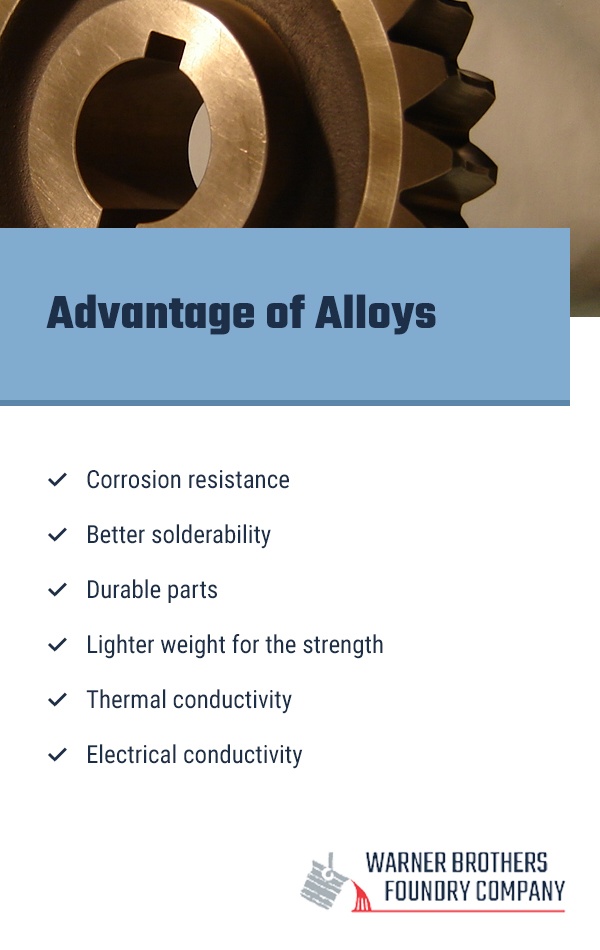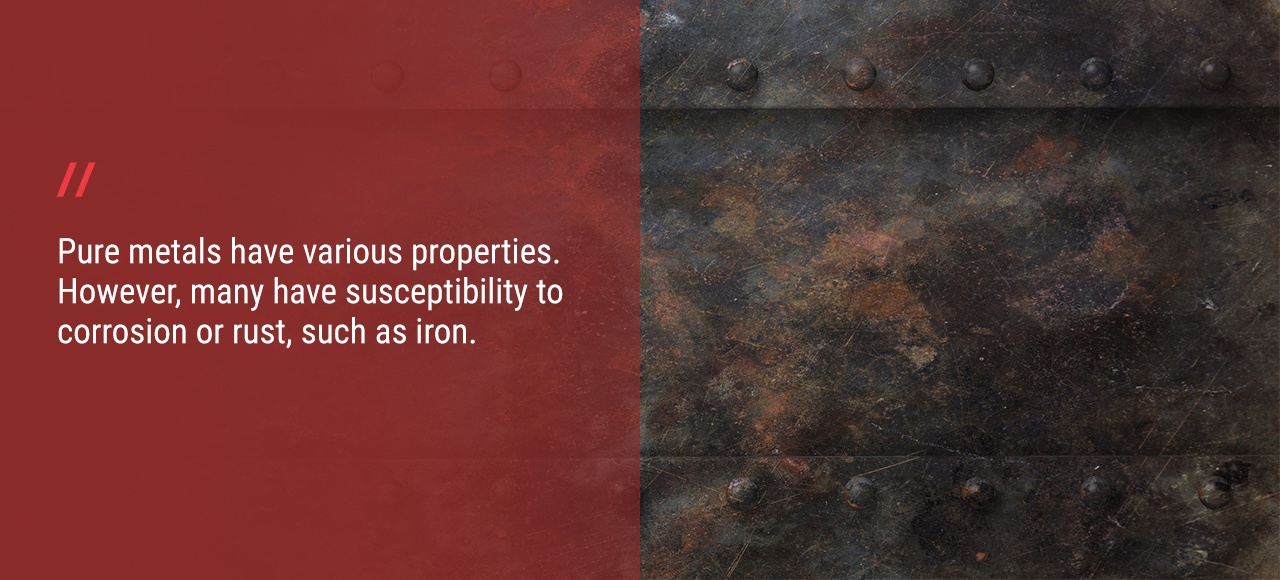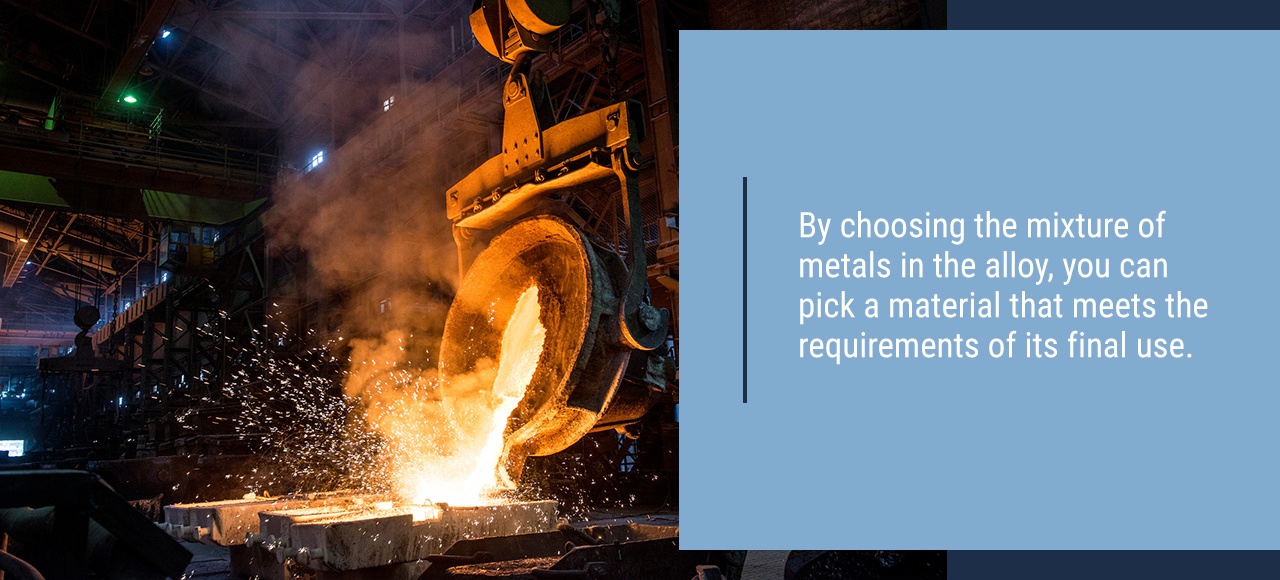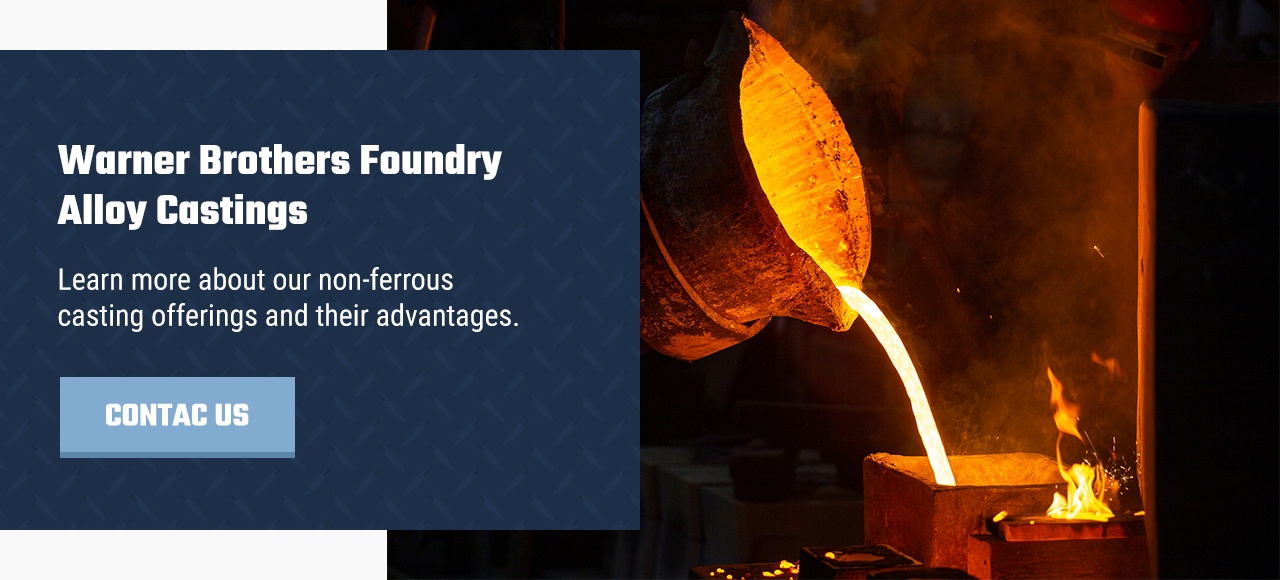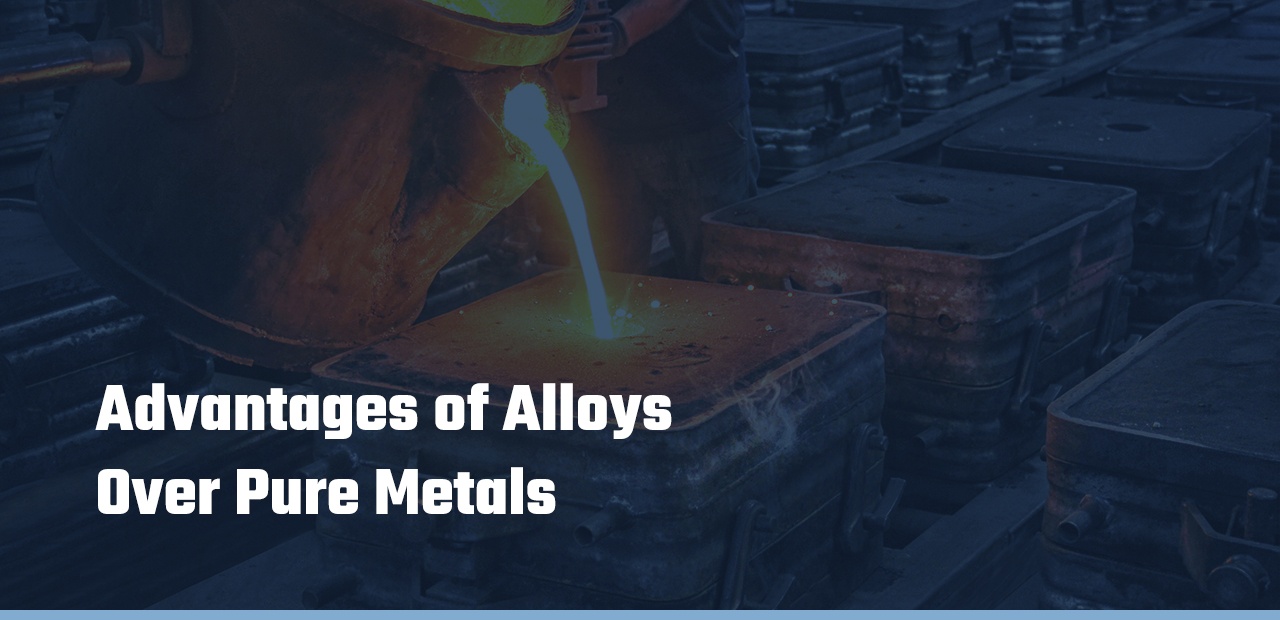
Table of Contents
- About Alloys
- Types of Alloys
- About Pure Metals
- Types of Pure Metals
- Metal vs. Alloy Properties
- Advantages of Alloys
Alloys solve many problems inherent in using pure metals for various projects. Pure metals are softer, prone to corrosion damage and more expensive than alloys. Therefore, the properties of alloys allow for more options and applications than pure metals. To appreciate these advantages, know how these materials differ in their properties and applications. By choosing alloys, you have better options for castings and other metal projects than using pure metals.
What Is an Alloy?
Alloys combine two or more substances to create a product with better properties than any of its parts. Typically, alloys are the product of mixing metals, though other alloys exist that use metals and non-metals. For instance, carbon is a non-metallic component of steel.
Most alloys start by melting and combining two or more metals. During this mixing process, the metals may also undergo purification to remove contaminants that might negatively impact the product. Various methods for producing alloys all work to protect the molten mixture from oxidation. When melted in air, slag that forms on top blocks oxygen from contaminating the alloy beneath. Melting alloys in a vacuum also prevents oxidation. Arc melting and induction melting are two options for creating alloys that use electricity to aid in the melting and mixing processes.
What Do We Use Alloys For?
Alloys are so essential to manufacturing and industry that epochs of human history have their names attributed to specific materials. For example, the Bronze Age marked an era when humans discovered how to make this alloy by combining copper and tin. Brass mixes zinc and copper. While these alloys were vital to the ancient world and still have many applications today, steel alloys are the most commonly used types in the industry. Aluminum alloys are also valuable in manufacturing, especially for automotive components. Brass and bronze are other alloys used frequently for fittings, plumbing components and bearings.
Properties of Alloys
Alloys’ specific properties depend on the metals used to create them. For example, when gold melts with zinc, the resulting alloy has the luster of gold but with extra strength contributed from the addition of zinc. Metallurgists choose the types of metals to combine into alloys based on the final product’s desired characteristics.
Compared to pure metals, alloys have better corrosion resistance, lower costs, higher strength and better workability. The alloys’ production and composition determine specifics such as machinability, ductility and brittleness.
Advantage of Alloys
Alloys offer multiple benefits that pure metals don’t have. By using alloys, you get the advantage of a custom blend of metals that combines the materials’ positive attributes. Depending on the components in the alloy, the products that use them could have the following benefits over objects made from pure metals:
- Corrosion resistance
- Better solderability
- Durable parts
- Lighter weight for the strength
- Thermal conductivity
- Electrical conductivity
Experts in choosing alloys and combining the metals to make them in the perfect proportions can optimize their properties for the product used.
Alloy Examples
Alloys include multiple types of metal combinations. Here are some examples of alloys and their applications.
- Composition brass: Once called red brass, this all-purpose alloy works best for castings needing moderate machinability and strength, such as plumbing hardware or pipe fittings.
- Valve composition brass: Has similar composition and uses as composition brass.
- Manganese bronze: High-strength alloy for heavy-duty use except in environments that require corrosion resistance.
- Tin bronze: Used in various bushings, valve parts, gears, pumps, piston rings and bearings.
- Aluminum bronze: Equals manganese bronze in strength. Plus, it offers excellent corrosion resistance.
- 713.0 aluminum alloy: Does not require heat treatment to create strength and can work in applications that place high demands on the alloy.
- A356.0 aluminum alloy: Resistant to hot cracking, readily weldable and average for machining, this aluminum alloy suits automobile components such as transmission cases, rear-axle housings and oil pans.
- Titanium alloys: Titanium’s resistance to corrosion makes these alloys especially good for marine use, such as submarine components.
- More non-ferrous alloys
- More brass and bronze alloys
- More aluminum alloys
What Is a Pure Metal?
Pure metals do not have other ingredients mixed in with them. These metals exhibit only their natural properties. However, many metals have undesirable attributes that make using them in their pure form inappropriate for industrial applications. For instance, many pure metals, such as gold, are naturally soft due to their uniform atomic structure. However, by mixing them with different metals, the alloys introduce new atoms that strengthen the material.
Properties of Pure Metals
Pure metals have various properties. However, many have susceptibility to corrosion or rust, such as iron. Mixing iron with other metals produces rust-resistant stainless steel.
Weight is another property of pure metals corrected by alloying. Some metals, such as gold or iron, are naturally dense. However, combining these with aluminum or titanium enhances strength while reducing weight. Many aerospace projects use titanium alloys for extra strength and lighter weight that would not be possible with pure metals.
Pure Metal Examples
Pure metals appear in nature. Consider these examples of pure metals and how they enhance alloys.
- Gold: Can serve as a base metal in an alloy to ensure beauty for jewelry or conductivity in electronics.
- Titanium: Adds strength without contributing extra weight in alloys.
- Copper: This metal offers corrosion resistance, thermal and electrical conductivity and ductility to alloyed metals.
- Aluminum: Like titanium, aluminum is a base metal added to alloys to enhance machinability, corrosion resistance and weight reduction.
- Zinc: Zinc most often plays a role in galvanizing steel to protect it against corrosion.
- Tin: Tin works well in many cold-working applications, including spinning, rolling and extruding. Additionally, it provides corrosion protection for other metals when alloyed with them.
The above pure metals can also combine with each other or with other metals to produce alloys.
How Is an Alloy Different From a Pure Metal?
The combination of metals produces alloys with more desirable properties than those found in pure metals. Physical and chemical properties make alloys preferable for multiple industrial applications across various sectors. Alloys and pure metals differences include the following.
Alloys vs. Pure Metals: Physical Properties
Alloys have different physical properties from pure metals. These changes include amendments in mass, conductivity, workability and thermal tolerance.
For mass, alloyed metals can be less dense than pure metals while maintaining the same strength. The automotive and aerospace industries prize aluminum and titanium alloys for their lightweight strength.
Conductivity determines how well the metals or alloys can transfer electrons for heat or electricity transfer. Integrating different metals can enhance or reduce heat or electricity transfer, depending on the product’s final use. For example, copper alloys offer high conductivity due to copper’s innate ability to transfer electrons well.
Workability indicates how well the materials can endure changing their shape through cold or heated methods. Some pure metals are so soft that they have good workability but low strength. Alloying these captures strength and workability, which is why often alloys are harder than other metals. For example, cold working and incorporation into alloys quickly lend extra strength to pure tin.
Lastly, thermal tolerance or melting points of pure metals change when alloyed with other materials. Pure metals have one melting point, a temperature at which their solid form turns to liquid. However, alloys have a range of temperatures that can cause changes to the material’s structure. Often, this range is higher than for individual metals. Therefore, alloys offer superior thermal stress resistance in most instances, compared to pure metals.
Alloying pure metal changes the physical properties to improve them for increasing the number of applications possible for alloys.
Alloys vs. Pure Metals: Chemical Properties
The most significant difference between alloys and pure metals happens on a molecular level. The two do not have the same chemistry. Pure metals have atoms only of that element — for instance, all iron or gold. These pure metals usually undergo processes to remove impurities of other materials. Alloys have atomic components of multiple elements. Therefore, they have a chemical structure different from pure metals.
Physical properties change due to alterations on an atomic level. These changes happen because the chemistry of the metals becomes different when alloyed. For instance, pure metals often react readily with other chemicals in the environment, leading to rust. Mixing these metals with others to prevent corrosion improves their longevity.
Another type of chemical change that occurs when mixing metals is the material’s enhanced molecular stability. The movement of atoms inside the structure of metal can affect the material’s strength. Atoms move readily through pure metals because they are all the same. However, mixing one metal with another introduces different-sized atoms that hinder movement, making the alloys stronger.
Advantages of Alloys in Castings — Why Are Alloys More Useful Than Pure Metals?
The differences between pure metals and alloys make alloys much more useful for several applications. By choosing the mixture of metals in the alloy, you can pick a material that meets the requirements of its final use. For instance, by opting for stainless steel over iron, you get longer-lasting, corrosion-resistant metal that can stand up better to the elements.
Alloys offer corrosion resistance pure metals cannot. Therefore, they are useful in situations that may expose them to chemicals, water, sea salt or steam. These environments would quickly wear down many pure metals, such as iron.
Another benefit of alloys over pure metals is their extra strength. Combining metals enhances the finished product’s structural integrity. This quality makes alloys useful for heavy-duty or high-stress applications, such as those inside engines.
Lastly, choosing alloys over pure metals gives you more control over the finished part’s weight. Alloys can offer strength without weighing down cars, airplanes or other vehicles that require lightweight, durable metals in their construction.
Why Should We Use Alloys Instead of Pure Metals for Castings?
While the benefits of alloys over pure metals are clear, many individuals still wonder, “Why are alloys preferred to pure metals in castings?” This common question needs addressing to ensure customers choose the correct metal for their product.
Due to the structure of pure metals, several issues can result within finished products. The metals may corrode easily or fail to meet the application’s strength requirements. Additionally, using pure metals may make the parts too expensive or too heavy for mass production. Alloys overcome these problems from pure metals by creating durable components, pieces with more corrosion resistance, lower weights, more thermal resistance or lower costs. Therefore, when choosing castings, alloys are the best option.
Alloys outperform pure metals for castings in many ways. The next choice is determining the type of alloys to use. The combination of metals, their proportions and the casting process will all impact the properties of the components created. Therefore, choose the alloys carefully based on what you need from them. For instance, some parts may require extra strength, lower weight, more thermal resistance, better protection from corrosion or enhanced functioning under stress.
How Quality Control During the Casting Process Makes a Difference
The specific process used for casting also makes a difference in quality, almost as much as the choice between using an alloy and pure metal. Pure metals come with inherent problems that combining them into alloys overcomes. However, casting with alloys needs to follow careful methods to ensure the finished part’s quality.
First, the size and shape of grains in the material determine the quality of the casting. The process should use lower temperatures for the alloy poured into the casting and faster cooling rates to optimize the finished product. With die-casting, chilling the mold hastens the cooling of the metal over sand casting, producing smaller grains. In some instances, adding grain refiners can also help reduce the sizes of particles in the alloys.
Second, changing the state of alloys also impacts the final quality. Phase changes, such as freezing, cause inclusions to force themselves into the spaces between dendrite arms. More space between these arms negatively impacts casting quality.
Third, minimizing air entry into the casting reduces porosity. Quickly cooling the casting can reduce air integrating into the metal. However, air will still get into the part with die-casting methods. There are ways to minimize air contamination, though. Options to do this include using methods other than die-casting. Gravity-fed or low-pressure casting can solve the problem of porosity and the subsequent brittleness it causes.
Warner Brothers Foundry Alloy Castings
Unlock your source for high-quality alloy castings delivered promptly. Learn more about our non-ferrous casting offerings and their advantages. We use a unique process known only to our metal casting company. Therefore, no one else can deliver the quality we do. By integrating top-notch materials with our proprietary process, we can achieve results like no one else for alloy castings and more. Once you’ve decided on your project’s parameters, contact us at Warner Brothers Foundry for a quote.


